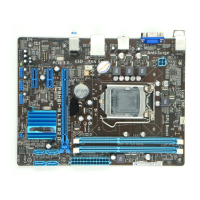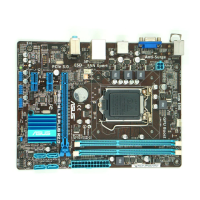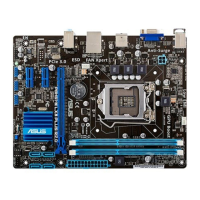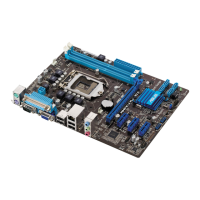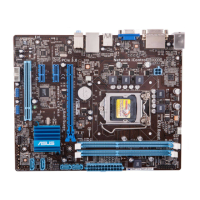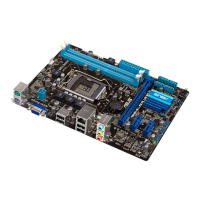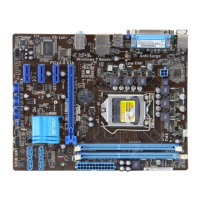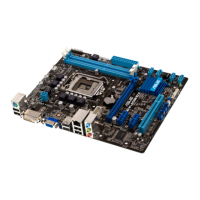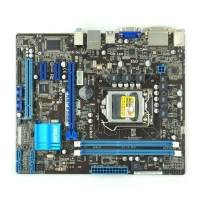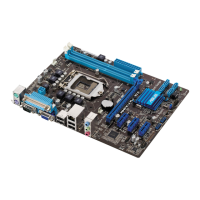Do you have a question about the Asus P8H61-M LX3 PLUS and is the answer not in the manual?
Precautions for electrical safety during installation and operation of computer hardware.
Guidelines for safe handling and installation of computer components and peripherals.
Information regarding ASUS compliance with REACH regulations for chemical substances in products.
Explains the structure and organization of the user manual for easy navigation and understanding.
Details the meaning of various symbols used in the manual to ensure user safety and correct component handling.
Provides guidance on understanding and using jumpers and illustrations for motherboard configuration.
Directs users to the ASUS website for product information and updates.
Mentions other documents that may be included with the product packaging for additional information.
Details CPU socket compatibility, supported Intel processors, and Turbo Boost technology.
Specifies the Intel H61 Express chipset used on the motherboard.
Information on DDR3 memory slots, maximum capacity, speed support, and dual-channel architecture.
Lists the available PCI Express x16 and x1 slots for expansion cards.
Details the supported D-Sub output and maximum UMA memory.
Specifies the Intel H61 Express chipset and Serial ATA 3Gb/s interfaces.
Highlights the integrated Realtek 8111F PCIe Gigabit LAN controller.
Mentions the VIA VT1708S high-definition 8-channel audio codec.
Details the number of USB 2.0 ports available on the motherboard.
Lists ASUS proprietary features like Anti-Surge, UEFI BIOS, AI Suite II, and Fan Xpert.
Notes the use of 100% high-quality conductive polymer capacitors for enhanced durability.
Describes the connectors and ports located on the rear panel of the motherboard.
A welcoming message for new ASUS motherboard users.
Lists the standard accessories included in the motherboard package.
Details the motherboard's support for Intel LGA1155 processors and DDR3 memory.
Essential safety and handling precautions to take before installing the motherboard.
Guides on the correct placement and orientation of the motherboard inside the computer case.
Identifies the screw hole positions for securing the motherboard to the computer chassis.
A visual diagram illustrating the placement of key components and connectors on the motherboard.
Detailed descriptions of various motherboard connectors, jumpers, and indicators with page references.
Step-by-step instructions for safely installing the CPU into the motherboard socket.
Introduces the motherboard's DDR3 memory slots and their specifications.
Step-by-step guide for installing expansion cards into motherboard slots.
Guidance on setting up expansion cards, including BIOS configuration and driver installation.
Details the PCI Express x1 slot and its compatibility with various expansion cards.
Describes the PCI Express x16 slot for graphics cards and other high-bandwidth devices.
Instructions for clearing CMOS settings using the CLRTC jumper to reset BIOS configurations.
Details the function and connection of ports on the motherboard's rear panel, including PS/2, LAN, and audio.
Recommendations for installing operating systems like Windows XP/Vista/7 for optimal hardware performance.
Information about the software and utilities included on the driver CD for enhancing motherboard performance.
Covers BIOS management, backup, and updating procedures using ASUS utilities.
Explains how to enter the BIOS setup utility during the system's Power-On Self-Test (POST).
Describes the EZ Mode interface, its system information display, and basic settings.
Explains the main menu items in Advanced Mode: Main, Ai Tweaker, Advanced, Monitor, Boot, Tool, Exit.
Allows users to select the display language for the BIOS setup utility.
Enables setting the system's current date and time.
Provides options for setting administrator and user passwords for system security.
Allows adjustment of the memory frequency for DDR3 modules.
Settings related to CPU features, clock ratios, and power management.
Options for configuring the system agent, including graphics adapter and memory allocation.
Settings for the Platform Controller Hub (PCH), such as high precision timers.
Controls for SATA devices, including mode selection (IDE, AHCI) and SMART status.
Settings for USB devices, including legacy support and EHCI hand-off.
Enables or disables onboard devices like HD Audio, LAN controller, and PXE ROM.
Advanced Power Management settings, including AC power loss restore and wake-on functions.
Displays real-time CPU and motherboard temperatures.
Monitors the rotational speed of CPU and chassis fans.
Enables or disables the CPU Q-Fan control for automatic fan speed adjustment.
Sets whether the NumLock key is enabled or disabled at system startup.
Enables or disables the display of a custom full-screen logo during boot.
Configures the system to wait for an F1 key press if an error occurs during boot.
Launches the ASUS EZ Flash 2 utility for BIOS updates.
Displays Serial Presence Detect (SPD) information for installed memory modules.
Allows saving and loading BIOS settings profiles for overclocking.
Restores BIOS settings to their factory default values.
Saves the current BIOS settings and restarts the system.
Exits the BIOS utility without saving any changes.
Allows switching to the ASUS EZ Mode interface from the Exit menu.
| Non-ECC | Yes |
|---|---|
| Memory channels | Dual-channel |
| Memory slots type | DIMM |
| Number of memory slots | 2 |
| Supported memory types | DDR3-SDRAM |
| Maximum internal memory | 16 GB |
| Supported memory clock speeds | 1066, 1333 MHz |
| Processor socket | LGA 1155 (Socket H2) |
| Processor manufacturer | Intel |
| Compatible processor series | Intel Celeron, Intel Pentium |
| Maximum number of SMP processors | 1 |
| USB 2.0 connectors | 3 |
| Number of SATA II connectors | 4 |
| USB 3.2 Gen 1 (3.1 Gen 1) connectors | 0 |
| USB 2.0 ports quantity | USB 2.0 ports have a data transmission speed of 480 Mbps, and are backwards compatible with USB 1.1 ports. You can connect all kinds of peripheral devices to them. |
| Audio chip | VIA VT1708S |
| Cooling type | Passive |
| Component for | PC |
| Power source type | ATX |
| Motherboard chipset | Intel® H61 |
| Audio output channels | 7.1 channels |
| Motherboard form factor | micro ATX |
| Supported storage drive interfaces | SATA II |
| Maximum resolution | 2048 x 1536 pixels |
| Maximum graphics card memory | 1748 MB |
| Parallel processing technology support | Not supported |
| PCI Express slots version | 2.0 |
| Cables included | SATA |
| LAN controller | Realtek RTL8111F |
| Networking features | Gigabit Ethernet |
| Ethernet interface type | Fast Ethernet, Gigabit Ethernet |
| BIOS type | UEFI |
| BIOS memory size | 32 Mbit |
| Depth | 173 mm |
|---|---|
| Width | 226 mm |
